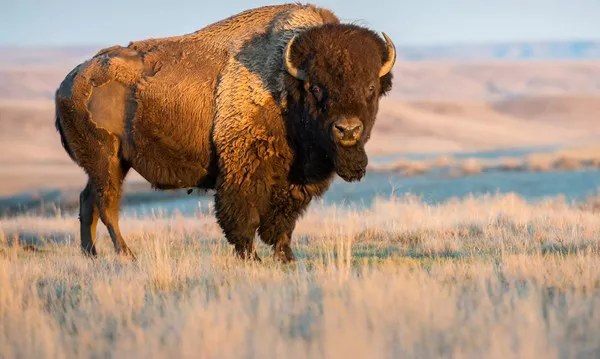North America, with its diverse ecosystems ranging from rugged mountains to expansive grasslands, is home to an array of fascinating mammalian species. Among these inhabitants are some of the continent’s largest and most awe-inspiring creatures. In this exploration, we delve into the realm of North America’s top 10 biggest mammals, shedding light on their remarkable size, habitats, and ecological significance.
North America’s Top 10 Largest Mammals
1. American Bison (Bison bison)
Standing as a symbol of the American West, the American bison holds the title of North America’s largest land mammal. These majestic herbivores once roamed the continent in vast herds, shaping the landscape with their presence. Adult male bison, known as bulls, can weigh up to 2,000 pounds (907 kilograms) and stand over 6 feet (1.8 meters) tall at the shoulder. Despite facing near-extinction in the past, concerted conservation efforts have helped restore bison populations in various parts of North America.
2. American Black Bear (Ursus americanus)
The American black bear, found throughout forested regions of North America, ranks among the continent’s largest carnivores. While smaller than its grizzly cousin, the black bear can still reach impressive sizes, with adult males weighing up to 600 pounds (272 kilograms). Despite their name, American black bears can display a range of coat colors, including shades of black, brown, cinnamon, and even white.
3. Moose (Alces alces)
Known for its towering stature and distinctive antlers, the moose is the largest member of the deer family and one of North America’s most iconic mammals. Adult male moose, known as bulls, can weigh between 900 and 1,500 pounds (408 to 680 kilograms) and stand over 7 feet (2.1 meters) tall at the shoulder. These solitary herbivores inhabit boreal forests, marshlands, and tundra regions across Canada and parts of the northern United States.
4. Grizzly Bear (Ursus arctos horribilis)
Renowned for its immense size and formidable presence, the grizzly bear is one of North America’s most formidable predators. Adult male grizzlies can weigh up to 1,500 pounds (680 kilograms) and stand over 9 feet (2.7 meters) tall when standing on their hind legs. These apex predators inhabit a range of habitats, including forests, mountains, and tundra, where they play a vital role in regulating ecosystem dynamics.
5. Polar Bear (Ursus maritimus)
As the largest bear species on Earth, the polar bear reigns supreme in the Arctic regions of North America. Adult male polar bears can weigh between 900 and 1,600 pounds (408 to 726 kilograms) and stand over 10 feet (3 meters) tall when standing upright. These formidable predators are superbly adapted to their icy habitat, relying on their keen sense of smell and powerful swimming abilities to hunt seals and other marine prey.
6. American Mastodon (Mammut americanum)
Although extinct for thousands of years, the American mastodon deserves recognition as one of North America’s largest mammals. This prehistoric relative of the elephant roamed the continent during the Pleistocene epoch, reaching sizes comparable to modern-day elephants. Adult male mastodons could weigh up to 8 tons (7,257 kilograms) and stood over 10 feet (3 meters) tall at the shoulder, making them formidable herbivores in ancient ecosystems.
7. North American Elk (Cervus canadensis)
Also known as wapiti, the North American elk ranks among the continent’s largest cervids. Adult male elk, known as bulls, can weigh between 700 and 1,100 pounds (318 to 499 kilograms) and stand over 5 feet (1.5 meters) tall at the shoulder. These majestic herbivores inhabit diverse habitats, including forests, grasslands, and alpine meadows, where they play a crucial role in shaping vegetation dynamics through grazing and browsing.
8. American Alligator (Alligator mississippiensis)
As one of North America’s largest reptiles, the American alligator commands respect in the wetlands and swamps of the southeastern United States. Adult male alligators can reach lengths of up to 13 feet (4 meters) and weigh over 500 pounds (227 kilograms). These apex predators play a vital role in maintaining the health of aquatic ecosystems, controlling prey populations and shaping wetland habitats through their feeding behaviors.
9. Gray Wolf (Canis lupus)
Although not the largest carnivore on the continent, the gray wolf still ranks among North America’s most iconic and ecologically significant mammals. Adult male wolves can weigh between 70 and 100 pounds (32 to 45 kilograms) and stand over 3 feet (0.9 meters) tall at the shoulder. These highly adaptable predators inhabit a range of habitats, including forests, tundra, and grasslands, where they play a crucial role in regulating prey populations and maintaining ecosystem balance.
10. North American Brown Bear (Ursus arctos)
Also known as the brown bear or the grizzly bear (when found in interior regions), the North American brown bear ranks among the continent’s largest terrestrial mammals. Adult male brown bears can weigh between 500 and 900 pounds (227 to 408 kilograms) and stand over 7 feet (2.1 meters) tall at the shoulder. These formidable predators inhabit a range of habitats, including forests, mountains, and coastal areas, where they play a vital role in shaping ecosystem dynamics through their feeding behaviors.
Conclusion
From the vast grasslands of the American West to the icy realms of the Arctic, North America is home to a remarkable array of large mammals. These majestic creatures, ranging from bison and bears to moose and elk, play vital roles in shaping ecosystems, regulating prey populations, and maintaining biodiversity across the continent. As stewards of the natural world, it is our responsibility to cherish and protect these magnificent species for generations to come.
You Might Be Interested In:



























